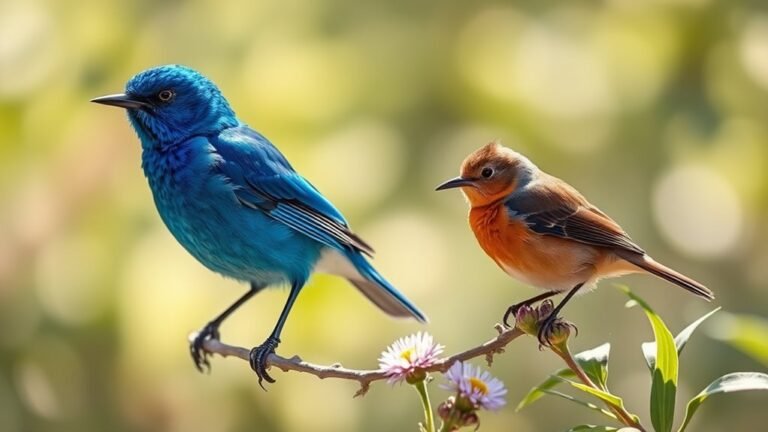Birds That Look Like Bats: Nocturnal Flyers Explored
When you look at the night sky, some birds resemble bats. Nightjars and swiftlets fly in ways that mimic these mammals. They have special traits that help them thrive in low light. Observing these birds reveals their importance in ecosystems and the challenges they face. Understanding these aspects enhances our appreciation of nature's balance.
Key Takeaways
Birds like nightjars and swiftlets fly at night and behave similarly to bats. Oilbirds and potoos use echolocation and blend into their dark surroundings. Common nighthawks glide smoothly at twilight, using their sharp wings to quickly catch insects. These birds help the ecosystem by pollinating plants, controlling pests, and dispersing seeds. Conservation efforts are vital to address dangers like habitat loss, climate change, and light pollution that affect these nocturnal birds.
The Mysterious Nightjar: Masters of Camouflage

Nightjars are hard to spot because they blend into their environment.
During the day, they rest on leaf litter or bare ground, where their mottled feathers look like fallen leaves. This helps them stay hidden from predators and people.
At dusk, nightjars become stealthy hunters. They fly silently through forests and grasslands, catching insects with quick wingbeats.
Finding a nightjar can be challenging for birdwatchers, but it can also create a special bond as you join the search for these unique birds.
Their adaptability highlights the wonders of nature.
Swiftlets: Aerial Acrobats With Bat-Like Agility
Swiftlets are known for their impressive flying skills and agility. They live in various places, including tropical forests and urban areas. Swiftlets are adaptable birds.
When you watch them, you can see their unique flight patterns. They twist and dart through the sky, often looking like bats.
These birds use echolocation-like abilities to find insects while flying. Their nesting habits include dark caves or sheltered ledges, which suit their nighttime lifestyle.
Oilbirds: Nocturnal Navigators of the Tropics

Oilbirds live in the tropical forests of South America. They're interesting because they're active at night.
Oilbirds make their homes in caves and rocky areas, where they sleep and raise their young. They've a special ability: they use echolocation, similar to bats, to find their food. Their diet mainly consists of ripe fruits and high-fat seeds.
Watching Oilbirds fly at night is a remarkable experience. They're skilled in flight and enjoy being with each other.
As they communicate in the darkness, they strengthen their social bonds. Oilbirds remind us of the connections between different species, even in the night.
Potoos: Ghostly Guardians of the Night
As night falls in tropical areas, a unique bird called the Potoo appears. These birds are known for their amazing ability to hide and their interesting behaviors.
- Potoos blend in with tree bark, making them nearly invisible due to their excellent camouflage.
- They make haunting calls that echo through the quiet night, reminding you of their presence.
- With wide mouths, they catch insects while flying, showing their effective feeding methods.
Potoo behaviors, like their silent watchfulness and hidden resting positions, highlight their adaptations for life at night.
Observing these enchanting birds helps you appreciate nature's beauty, as stealth and grace flourish in the moonlight.
Night-Herons: Silent Stalkers of Wetlands

Night-herons are often unnoticed, but they play an important role in wetlands.
These birds hunt for fish and frogs at night, using their sharp eyes and quick movements. They've distinctive feathers that help them blend into their surroundings.
Watching a night-heron catch its prey highlights the balance of life in wetland ecosystems. These hunters are key to the natural order, and observing them creates a connection to the environment.
In the calm of dusk, night-herons offer a glimpse into the quiet yet vibrant world of wetlands.
Common Nighthawks: Winged Wonders of the Twilight Sky
In the fading light of dusk, common nighthawks take to the sky. They glide smoothly, their shape similar to that of a bat. Watching these birds reveals interesting behaviors. As night approaches, they feed in the twilight, showing off their flying skills.
- Their sharp, narrow wings help them twist and dive quickly.
- They often perch silently, looking for insects.
- Their distinct call can be heard in the quiet, pulling you into the experience.
As you watch their easy flight, you feel a connection to nature during this time of day. Each evening, new mysteries of the natural world unfold.
Whip-poor-wills: Haunting Calls in the Darkness
The night air often carries the calls of whip-poor-wills. Their sounds echo through the darkness like a songbird's lament.
Listen closely, and you'll hear their repeated calls, creating a rhythmic pattern. These calls help them mark their territory and attract mates. The sounds connect them to their environment.
Whip-poor-wills blend into the shadows, inviting reflection on the beauty of nature. When you hear their calls, they remind you of life's simplicity and wonder under the moonlit sky.
Tawny Frogmouths: Masters of Stillness
As night falls and whip-poor-wills call, the tawny frogmouth emerges among the trees. These birds have unique features that help them blend into their environment.
- Their feathers look like tree bark, which helps them camouflage.
- Their wide, flat mouths allow them to catch insects quickly while flying.
- Their stillness serves as a hunting strategy, making them effective predators.
Watch the tawny frogmouth as it perches quietly, waiting for the right moment to catch its prey.
This impressive stillness not only captivates birdwatchers but also highlights the strong connection between these birds and their environment.
This relationship emphasizes nature's balance and beauty.
Scissor-tailed Flycatchers: Elegant Night Flyers
Scissor-tailed flycatchers fly gracefully in the twilight skies. Their long tails resemble scissor blades, adding to their beauty.
These birds have unique features that help them fly smoothly. Watch how their tails rise high, guiding their movements. In low light, their quick moves become even more impressive.
They dart among trees, catching insects in mid-air. This captivating scene pulls you closer to these amazing birds.
With every swoop, scissor-tailed flycatchers show the beauty of nature, reminding us of the balance of our ecosystems.
Mexican Free-tailed Bats: Misidentified Avian Friends
While flying at dusk, you might see Mexican free-tailed bats. Their large wingspan often leads people to mistake them for birds. These bats have interesting lives and aren't pests, despite what some urban myths suggest. They show rich social behaviors and unique habits.
- Diet: They mainly eat insects, helping manage local insect populations.
- Social Life: These bats roost in colonies, creating close communities that promote social interaction.
- Flight: Their rapid, agile flights help them avoid dangers, demonstrating their ability to adapt.
Learning about these nocturnal animals can increase your appreciation for nature. It also helps correct common misunderstandings, inviting you to enjoy their remarkable stories.
Chuck-wills-widows: Mysterious Nighttime Singers
Chuck-wills-widows appear at twilight, their calls echoing through the night. These birds thrive in open woodlands and bushy areas, where they find food and shelter. They often sit quietly, camouflaging themselves until night falls.
Their songs create a melodic reminder of the evening's mystery, adding depth to the surroundings. When you listen closely, their calls can evoke feelings of connection with nature.
European Nightjars: Their Striking Similarities With Bats
As dusk falls, the European Nightjar captures attention. This bird shares similarities with bats due to its night-time activities and shy behavior.
Here are some key traits they share:
- Nocturnal habits: Both nightjars and bats are most active at night, feeding and moving under the cover of darkness.
- Camouflage: The nightjar's mottled feathers help it blend into the ground, making it hard to see for predators and watchers.
- Sounds: Nightjars make eerie calls that add to their mysterious nature, creating a unique sound in the evening air.
These traits highlight how nightjars and bats have adapted to live and thrive in night environments.
Frequently Asked Questions
Do Any Birds Actually Eat Bats?
Some birds feed at night and may occasionally eat bats. This behavior allows them to thrive in areas where bats are common. These interactions illustrate the connections within nature's food web.
How Do Bird and Bat Flight Differ?
Birds and bats fly differently due to their unique wing structures. Birds have wings that allow for flapping motion. Bats have flexible membranes that create a different kind of flight. These differences affect how agile and fast they are in the air. Birds tend to be quicker in straight lines, while bats are more maneuverable, allowing for sharp turns and swift changes in direction. This variation in flight strategies helps both groups thrive in their environments.
Can Birds and Bats Coexist Peacefully?
Birds and bats can live together peacefully. They use cohabitation strategies to reduce competition for food and other resources. This cooperation allows them to share their habitats effectively. Both animals play important roles in the ecosystem, helping to maintain balance. Together, they enhance biodiversity and support their shared environments. This coexistence benefits not just birds and bats but also the ecosystems where they thrive.
What Are the Predators of Nocturnal Birds?
Nocturnal birds have several predators. The main threats come from nocturnal raptors, particularly owls. Owls are skilled hunters. They use sharp hearing and silent flight to catch their prey. This makes them dangerous to unsuspecting birds at night. Other potential predators include larger mammals and snakes that may hunt birds resting or nesting.
How Do Birds Navigate at Night?
Birds find their way at night using excellent night vision and echolocation. Their sharp eyesight helps them see in low light, allowing them to avoid obstacles and spot food. Echolocation helps some birds locate objects and navigate their surroundings. These skills are vital for their survival in dark environments.

Ava is a bird enthusiast and nature lover who has spent countless hours observing and learning about the fascinating world of birds. With a passion for sharing her knowledge and inspiring others to appreciate the beauty of birds, Ava writes about her experiences and insights on avianadmirer.com.







